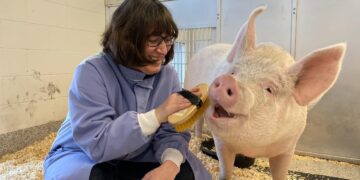Table of Contents
Prologue: The Show That Flopped
The story of Sarah and Buster is a common one, a short-run production that closes after a disappointing premiere.
Sarah, a young professional living in a stylish downtown apartment, decided she needed a co-star for her life.
After scrolling through countless profiles online, she found him: Buster, a terrier mix with wiry, expressive eyebrows and an energy that seemed to leap through the screen.
The adoption agency’s description read “active and playful,” which Sarah interpreted as the perfect running buddy for her weekend jogs.
The decision was made based on a headshot and a single character trait.1
The first week was a whirlwind of excitement.
But soon, the script of Sarah’s life began to clash with Buster’s innate character.
Her apartment, once a calm sanctuary, became the stage for a chaotic one-dog show.
Buster’s “active” nature wasn’t suited for occasional jogs; it was a relentless, high-energy drive that, when confined to 700 square feet, manifested as shredded pillows and chewed-up furniture.2
His barks—at the mail carrier, at footsteps in the hallway, at the distant sound of a siren—became a constant source of tension with neighbors in the thinly walled building.3
Sarah’s demanding work schedule meant Buster was left alone for nine hours a day.
His initial whimpers escalated into the full-blown panic of separation anxiety, resulting in accidents on the new rug and frantic calls from the building manager.5
Sarah tried longer walks in the morning, expensive puzzle toys, and crating him, but nothing seemed to work.
The joy she had anticipated was replaced by a draining cycle of frustration, guilt, and anxiety.
It wasn’t that Buster was a “bad dog” or that Sarah was a “bad owner.” The problem was a simple, yet profound, miscasting.
Buster was a high-energy character actor cast in a quiet, dramatic role.
Sarah was a first-time director who had chosen a star without fully reading the script of her own life.
This guide is built on a new perspective: choosing a dog is not like buying a product.
It is like casting a play.
Success depends not on finding the “best” actor, but the right actor for a specific role, on a specific stage, under a specific director.
By embracing the role of director, any prospective owner can set the stage for a long-running hit.
Part I: The Director’s Vision — Understanding Your Life’s Script
Before a single actor auditions, a director must intimately understand the production they are mounting.
They analyze the script’s genre, pace, budget, and the demands it will place on the cast.
As the director of your own life, a similar analysis is the foundational first step.
Your lifestyle, habits, resources, and personality are the script.
A dog must be able to perform its role within that script, day after day, for its entire life.
This self-assessment is not about judgment; it is about the honest discovery of your “Capacity for Care”—a finite resource composed of your available time, energy, money, and emotional bandwidth.
The perfect canine partner is one whose needs do not exceed your capacity to provide.
The Script’s Genre & Pace (Your Personality & Activity Level)
The first step in script analysis is identifying its genre.
Is your life a quiet, contemplative drama, a high-octane action film, or a cozy romantic comedy? This translates to your personality and energy level.
A prospective owner must ask: Am I an active person or more laid-back?.6
Am I a happy homebody who desires a constant companion—a “velcro dog”—or an independent adventurer seeking a trail buddy?.7
This analysis must go deeper than a simple “active” versus “couch potato” dichotomy.
The type of activity is paramount.
For apartment dwellers without a yard, this distinction is critical.
One common myth is that a dog’s size dictates its energy level; in reality, a 20-lb Jack Russell Terrier, bred for vigorous hunting, may have far greater and more intense exercise needs than a 150-lb Great Dane, a famously low-energy giant.9
The terrier may require explosive, high-intensity games of fetch to remain content, while the Dane is satisfied with a long, lumbering walk.
Understanding the specific nature of a breed’s energy needs is essential to preventing the destructive behaviors that arise from boredom and pent-up frustration.2
The Production Schedule (Your Time & Availability)
A director must have a firm grasp of the production schedule.
How many hours a day will the lead actor be on set? How much time will they spend alone in their trailer? For a dog owner, this translates to an honest assessment of daily and weekly schedules.
Key questions include: “How much time will your new dog be spending alone?” and “Does your job require frequent travel?”.10
Leaving a dog alone for eight or more hours a day can be the root cause of many common behavioral issues.
This isolation can lead to profound boredom, which often manifests as destructive chewing or nuisance barking.3
For highly social breeds that were bred for companionship, such as the Cavalier King Charles Spaniel, prolonged solitude can trigger severe separation anxiety.12
This is not a failure of the dog’s character, but a predictable effect of its needs not being M.T. An honest evaluation of one’s work schedule, social life, and daily commitments is necessary to determine if the “production schedule” has enough time for a co-star who requires consistent companionship.
The Production Budget (Financial Realities)
No production gets off the ground without a realistic budget.
The initial adoption fee is merely the cost of securing the talent; the true financial commitment lies in the day-to-day and long-term costs of the production.
A responsible director budgets for everything.
This includes recurring expenses like high-quality food, routine veterinary check-ups, and grooming, as well as apartment-specific costs such as dog walkers or doggy daycare, which can be essential for owners with long work hours.1
Furthermore, a significant portion of the budget must be allocated for potential emergencies and breed-specific health issues.8
For example, brachycephalic (flat-faced) breeds like the French Bulldog are prone to Brachycephalic Obstructive Airway Syndrome (BOAS), a condition that can require corrective surgery costing between $1,500 and $5,000.15
A Shih Tzu may develop chronic allergies requiring monthly medication that can cost over $100 per month.16
Factoring in pet insurance and a contingency fund is a non-negotiable part of responsible ownership.
The Supporting Cast (Your Household)
A lead actor does not perform in a vacuum.
Their chemistry with the supporting cast is crucial to the success of the show.
Before bringing a dog home, the director must consider everyone else on set.
Is everyone in the household in agreement on adopting a new pet?.10
A lack of consensus can create an unstable and stressful environment for an animal.
The presence of children or other pets drastically alters the casting requirements.
If there are young children, a breed known for its patience and gentle nature, like the Bulldog, might be a better fit than a breed that can be intolerant of childish behavior, like some Chihuahuas.1
If other pets are already in the home, it is vital to consider a dog’s general sociability with other animals and to facilitate slow, careful introductions.11
The entire household is part of the dog’s world, and their well-being depends on a harmonious ensemble.
The Director’s Experience (Your Skillset)
Finally, a director must be honest about their own experience.
Is this their directorial debut, or are they a seasoned veteran? Key questions are: “Have you owned a dog before?” and “How much training will your new dog receive?”.11
A first-time owner may be overwhelmed by a highly intelligent or stubborn breed that requires a confident, consistent leader to thrive.7
Such breeds are not “difficult” but simply require a specific directorial style.
An owner who is unwilling or unable to commit to consistent training will struggle, regardless of the breed.
This self-assessment is about matching the dog’s needs to not only the owner’s lifestyle but also their capacity and willingness to lead and teach.
Part II: Setting the Stage — Analyzing Your Apartment Environment
Every performance is shaped by its stage.
A minimalist black box theater demands a different style of acting than a grand, ornate opera house.
Your apartment is the stage on which your dog will perform every day, and its unique characteristics—size, layout, acoustics, and rules—will profoundly influence their behavior and well-being.
A brilliant actor cannot deliver a great performance on a stage that works against them.
It is crucial to recognize that the physical environment is not a passive backdrop; it is an active variable that can either amplify a dog’s stress or serve as a foundation for its security.
The Dimensions of the Stage (Size and Layout)
The most common concern for apartment dwellers is space.
However, one of the most persistent myths in dog ownership is that a large dog cannot be happy in a small apartment.9
The truth is that a dog’s suitability for an apartment is determined far more by its energy level and temperament than by its physical size.17
As noted by experts, a low-energy, 150-lb Great Dane that is content to lounge for much of the day can be a far better fit for a small apartment than a high-strung, 20-lb Jack Russell Terrier that needs constant, vigorous activity to stave off destructive boredom.9
Large breeds like Greyhounds, often called “45-mph couch potatoes,” and Great Danes are frequently successful in apartments because their exercise needs can be met with daily walks and they are otherwise calm indoors.20
The key is not the square footage of the apartment, but the owner’s commitment to providing appropriate exercise
outside the apartment.
The Acoustics and Audience (Noise and Neighbors)
Apartment living is a communal experience defined by shared walls, floors, and ceilings.
The “acoustics” of your building are a critical consideration.
Thin walls, hardwood floors that transmit every click of a nail, and high-traffic hallways near elevators can create a challenging soundscape.3
This is a two-way issue.
A dog prone to barking can become a major point of contention with neighbors.4
Conversely, a constant barrage of external noises—doors slamming, people talking, other dogs barking—can be a significant source of stress for a sensitive or reactive dog, potentially triggering anxiety and defensive barking.23
If the living environment is particularly noisy or the lease has strict noise policies, prioritizing a quieter breed is a wise directorial choice.5
The Stage Manager’s Rules (Landlords and Leases)
The stage manager—in this case, the landlord or property management company—sets the non-negotiable rules of the production.
Before beginning the casting process, it is essential to thoroughly review the lease agreement.
Many buildings have specific restrictions on pet ownership, which may include weight limits, breed restrictions, pet rent, and non-refundable pet deposits.5
Breeds commonly found on restricted lists include German Shepherds, Dobermans, Rottweilers, Mastiffs, and various bully breeds, often due to insurance liability or reputation, however undeserved.23
Securing clear, written permission and understanding all associated fees and clauses is a critical step to prevent the heartbreaking scenario of having to rehome a beloved pet due to a lease violation.
The Backstage and Off-Set Locations (Neighborhood and Amenities)
The performance space extends beyond the four walls of the apartment.
The surrounding neighborhood serves as the “backstage” area and “off-set locations” where crucial needs are M.T. The availability of nearby parks, dog runs, or even just quiet, green spaces for walks can make a world of difference, especially for dogs with higher energy levels.23
The logistics of daily life must also be considered.
Potty training a puppy in a high-rise building presents a unique challenge; an apartment on the top floor means every urgent bathroom break requires a lengthy trip down the elevator and outside.2
For this reason, a ground-floor unit is a significant advantage.2
This reality highlights a paradoxical benefit of apartment living: it enforces proactivity.
Unlike a homeowner who can simply open a back door, an apartment dweller must engage in multiple, deliberate walks each day for every single potty break.
This “forced proactivity” often results in a more structured routine and a more deeply engaged relationship between owner and dog, as every need for exercise and relief becomes a shared activity.3
Part III: The Art of Casting — A Framework for Finding Your Star
With a comprehensive understanding of the script (your life) and the stage (your home), the casting process can begin.
This is where the director’s vision meets the reality of available talent.
The goal is not to find a universally “perfect” dog, but to identify the specific canine co-star whose innate traits and temperament will create a harmonious and successful “ensemble” with you and your environment.
This requires a systematic approach, moving from a broad character description to the nuanced assessment of individual candidates.
Writing the Character Brief (Defining Your Ideal Dog)
The first step in any casting process is to create a detailed character brief.
This document, born from the self-analysis in Parts I and II, outlines the essential qualities of the role you are looking to fill.
For apartment living, six traits are of paramount importance:
- Energy Level: This is the most critical factor. Is the role for a “couch potato,” a “casual walk buddy,” or a “world-class runner”? Be honest about the amount of daily physical and mental stimulation you can provide.25
- Temperament: What is the character’s core personality? Are you looking for an affectionate “velcro dog” who thrives on constant companionship, or a more independent character who is comfortable with some alone time? Is the role for a dog who is friendly with strangers or one who is more reserved and protective?.7
- Vocalness (Barking): How much dialogue is in the script? Given your building’s acoustics and your personal tolerance, is the role for a quiet character or can you accommodate some barking?.7
- Size: While not a direct indicator of energy, size has practical implications. It affects landlord rules, the cost of food and supplies, and how the dog physically fits into your space.6
- Grooming Needs: What is the budget for the “costume and makeup department”? This involves both the time and financial commitment required for brushing, bathing, and professional grooming.11
- Trainability/Independence: How does the character take direction? Are you looking for a dog who is eager to please and easy for a novice to train, or do you have the experience and patience for a more independent or stubborn character?.7
To make this process tangible, the following matrix serves as your personal casting worksheet.
By filling it out, you transform abstract preferences into a concrete blueprint for your search.
Table: The Director’s Casting Matrix
| Trait | My Director’s Brief (Ideal Rating: Low, Med, High) | My Stage’s Requirements (Non-Negotiable Limits) |
| Energy Level | ||
| Temperament | (e.g., Velcro, Independent, Social) | |
| Vocalness | ||
| Size | (e.g., Small, Med, Large) | (e.g., Under 50 lbs) |
| Grooming Needs | ||
| Trainability | (e.g., Eager to Please, Independent) |
Reviewing the Headshots (In-Depth Breed Research)
With your character brief in hand, you can begin reviewing the “headshots” of potential candidates—the vast world of dog breeds.
While online breed selector quizzes can be a starting point, they often provide generic results.26
A more effective approach is to conduct deeper research, focusing on a breed’s original purpose.
A terrier bred to fearlessly pursue vermin underground will possess a different set of instincts—like a tendency to dig and bark—than a spaniel bred for generations to sit calmly on a lap.26
Reputable sources like the American Kennel Club (AKC) and national breed club websites offer invaluable information on temperament, exercise needs, and common health problems.6
Paying close attention to the health profile is crucial, as inherited conditions can lead to significant emotional and financial costs down the line.26
Holding Auditions (The Meet-and-Greet)
No director would cast a role based on a headshot alone.
The audition is where you see the actor’s true capabilities.
For a prospective dog owner, the meet-and-greet is the most critical stage of the casting process.
Whenever possible, it is highly recommended to meet adult examples of a breed you are considering, as they provide a much clearer picture of the breed’s mature temperament than an irresistible puppy.26
This interaction is your “chemistry read”—a term from filmmaking used to see how actors perform together.28
During this “audition,” you should assess several key factors:
- Chemistry with the Director: How does the dog interact with you? Are they fearful, aloof, or engaged?
- The “Cold Read”: How does the dog handle a new situation? Introduce a new person or a sudden, gentle noise. Do they recover quickly from being startled, or do they remain anxious? This tests their adaptability.28
- Taking Direction: How do they respond to gentle guidance or a simple command? A dog’s ability to take direction is a strong indicator of their trainability and willingness to collaborate.30
Just as a casting director looks for authenticity and a natural presence, the goal is to see beyond the shelter environment and get a glimpse of the dog’s genuine personality.30
This is the moment where the data from your research meets the intangible connection that will form the foundation of your future partnership.
Part IV: Meet the Cast — Curated Profiles for Leading Roles
The following profiles represent a curated cast of “actors” who have a history of successful performances in the unique “production” of apartment living.
It is essential to recognize the “Trade-Off Principle”: there is no perfect dog.
Every breed comes with a distinct set of strengths and challenges.
A French Bulldog offers low energy but carries significant health risks; a Bichon Frise is hypoallergenic but requires intensive grooming.
The art of good casting is not finding a flawless candidate, but in choosing the set of trade-offs that you, the director, can happily and capably manage for the entire run of the show.
Use your completed Casting Matrix to evaluate which of these leading roles is the best fit for your production.
The Affectionate Companion (Role: The Lapdog, The Shadow)
These breeds are born for the role of devoted companion.
They thrive on human connection and are happiest when they are part of a close-knit ensemble.
Cavalier King Charles Spaniel
- Casting Matrix Scorecard: Energy: Low-Med; Temperament: Velcro/Social; Vocalness: Low; Size: Small; Grooming: Med; Trainability: Eager to Please.
- Temperament & Personality: Cavaliers are the quintessential lapdogs—gentle, affectionate, and endlessly sweet-natured. They are adaptable and generally get along well with children, strangers, and other pets, making them excellent family members.31 Their primary motivation is to be with their people.33
- Exercise & Enrichment Needs: A daily walk of around 30 minutes, split into two sessions, is typically sufficient to meet their physical needs. They are flexible, happy to be active or lazy depending on their owner’s lifestyle.32
- Grooming & Health: Their silky coat requires regular brushing several times a week to prevent mats.32 They are prone to serious genetic health conditions, most notably heart conditions like Mitral Valve Disease.
- Apartment Living Report Card: Cavaliers are nearly perfect apartment dogs in temperament, but their defining trait—their deep bond with their owners—is also their biggest challenge. They are extremely prone to separation anxiety and do not do well when left alone for long periods.12 This breed is best suited for households where someone is home most of the day.
Shih Tzu
- Casting Matrix Scorecard: Energy: Low; Temperament: Social/Affectionate; Vocalness: Med; Size: Small; Grooming: High; Trainability: Independent.
- Temperament & Personality: Bred for centuries as palace companions, Shih Tzus are loyal, outgoing, and charming. They have big personalities packed into a small frame and are generally friendly with people and other pets when socialized properly.36
- Exercise & Enrichment Needs: Their exercise needs are minimal. A short daily walk and some indoor playtime are usually enough to keep them content.36
- Grooming & Health: This is a major commitment. Their long, luxurious coat is low-shedding but requires daily brushing to prevent severe matting. Many owners opt for a shorter “puppy cut,” which requires professional grooming every 4-6 weeks.36 They are also a brachycephalic breed, prone to eye and dental problems.39
- Apartment Living Report Card: Their small size and low exercise needs make them physically well-suited for apartments.39 However, they can be stubborn and notoriously difficult to housetrain, requiring significant patience.16 They can also be prone to barking, either to alert or to demand attention.37
The Comedic Character Actor (Role: The Snorting Sidekick)
These breeds are known for their unique looks and outsized personalities, often stealing the scene with their charming and humorous antics.
French Bulldog
- Casting Matrix Scorecard: Energy: Low; Temperament: Social/Affectionate; Vocalness: Low; Size: Small; Grooming: Low; Trainability: Independent.
- Temperament & Personality: Frenchies are playful, alert, and adaptable clowns. They are incredibly human-oriented and thrive on being part of the family. They are generally quiet dogs, not prone to nuisance barking, which is a major asset in an apartment.18
- Exercise & Enrichment Needs: They require minimal exercise; short, leisurely walks are sufficient. Over-exertion is dangerous for them.18
- Grooming & Health: Their short coat is easy to care for, but their facial folds must be cleaned regularly to prevent infection.18 Their health is a significant concern. As a brachycephalic breed, they are highly susceptible to breathing problems (BOAS) and cannot tolerate heat or humidity. They are also prone to a host of other health issues.15
- Apartment Living Report Card: Their low energy, small size, and quiet nature make them seem like the ideal apartment dog.44 However, the director casting this role must be prepared for potentially high veterinary bills and the responsibility of managing their fragile health. They cannot be left in an apartment without air conditioning in warm weather.
Pug
- Casting Matrix Scorecard: Energy: Med; Temperament: Social/Charming; Vocalness: Low; Size: Small; Grooming: Med-High; Trainability: Independent.
- Temperament & Personality: Described by the motto multum in parvo (“a lot in a little”), Pugs are charming, mischievous, and loving companions. They are generally even-tempered and sociable with everyone.27
- Exercise & Enrichment Needs: They need moderate exercise, about an hour a day, to prevent obesity, to which they are prone. This can be achieved with brisk walks and playtime.45
- Grooming & Health: Despite their short coat, Pugs are notorious shedders. Regular brushing is required to manage the fur.45 Like French Bulldogs, they are a brachycephalic breed with associated breathing difficulties and heat intolerance. Their facial wrinkles also require regular cleaning.48
- Apartment Living Report Card: Pugs are adaptable and can thrive in apartments as long as their exercise needs are met.45 The main challenges are managing their heavy shedding in a small space and being vigilant about their health, particularly in warmer climates.48
The Charming Socialite (Role: The Welcoming Committee)
This breed is the life of the party, a cheerful and friendly character who assumes everyone is a friend they haven’t met yet.
Bichon Frise
- Casting Matrix Scorecard: Energy: Med; Temperament: Social/Playful; Vocalness: Med-High; Size: Small; Grooming: High; Trainability: Eager to Please.
- Temperament & Personality: The Bichon is a cheerful, charming, and playful dog with a merry disposition. They are highly social and generally get along well with children, other pets, and strangers.50
- Exercise & Enrichment Needs: They are active and require daily exercise, around 30 minutes of brisk walking and playtime, to prevent boredom.50
- Grooming & Health: Their coat is a major consideration. They are considered hypoallergenic because they shed very little, but their powder-puff coat requires daily brushing to prevent painful mats. They also need professional grooming every 4-6 weeks.51
- Apartment Living Report Card: Their small size and adaptable nature make them a good physical fit for apartments.53 However, they are prone to two significant apartment-living challenges: separation anxiety if left alone too long, and a tendency to be vocal barkers.50 Early training to manage barking is essential for maintaining peace with neighbors.56
The Sturdy Homebody (Role: The Gentle Guardian)
These breeds project an image of strength and dignity, but underneath lies a gentle, loving character actor who prefers a quiet life.
Bulldog
- Casting Matrix Scorecard: Energy: Low; Temperament: Calm/Loyal; Vocalness: Low; Size: Medium; Grooming: Med; Trainability: Stubborn.
- Temperament & Personality: Despite their sour expression, Bulldogs are sweet, gentle, and dependable companions. They are particularly known for being patient and loving with children. They are courageous but generally docile, forming strong bonds with their families.58
- Exercise & Enrichment Needs: Bulldogs have low endurance and require only moderate exercise, such as a couple of short, 15-minute walks per day. They are happy to spend the rest of the day snoozing.59
- Grooming & Health: Their coat is low-maintenance, but their deep facial wrinkles require daily cleaning to prevent skin infections.59 They are a brachycephalic breed with a long list of potential health problems, including respiratory issues, and they are extremely sensitive to heat.58
- Apartment Living Report Card: Their low exercise needs and generally quiet nature make them excellent candidates for apartment life.61 They do not need a large yard. The primary challenge for an owner is managing their significant health issues and being prepared for the associated costs and care requirements.63
The Low-Energy Gentle Giant (Role: The 45-MPH Couch Potato)
These breeds defy the myth that big dogs don’t belong in small spaces.
Their calm indoor demeanor and moderate energy needs make them surprisingly well-suited for apartment life.
Greyhound
- Casting Matrix Scorecard: Energy: Low-Med (sprints); Temperament: Gentle/Calm; Vocalness: Low; Size: Large; Grooming: Low; Trainability: Med.
- Temperament & Personality: Greyhounds are the prime example of why size is not a good indicator of apartment suitability. They are famously known as “45-mph couch potatoes.” Indoors, they are quiet, gentle, and mild-mannered, content to sleep for 18-20 hours a day.21
- Exercise & Enrichment Needs: They do not require hours of exercise. A daily walk and the occasional opportunity to sprint safely in a securely fenced area are all they need. They must never be off-leash in an unfenced area due to their speed and prey drive.21
- Grooming & Health: Their short, sleek coat requires minimal grooming. They are also a relatively healthy breed with fewer genetic issues than many other purebreds.21
- Apartment Living Report Card: Greyhounds are excellent apartment dogs. They are quiet, clean, and take up less space than one might think, as they often curl up when resting.21 The main commitment for an apartment dweller is ensuring they get their daily walks and safe opportunities to run, as there is no backyard for a quick sprint.64
Great Dane
- Casting Matrix Scorecard: Energy: Low-Med; Temperament: Gentle/Patient; Vocalness: Med; Size: X-Large; Grooming: Low; Trainability: Eager to Please.
- Temperament & Personality: Known as “gentle giants,” Great Danes are sweet, patient, and dependable. Despite their imposing size, they are generally calm and have low energy levels indoors.20
- Exercise & Enrichment Needs: An adult Great Dane’s exercise needs are moderate and can be met with two or three brisk walks per day. Over-exercising them, especially as puppies, can damage their rapidly growing joints.22
- Grooming & Health: Their short coat is easy to maintain. However, they are prone to serious health issues, including bloat (a life-threatening stomach condition), heart problems, and hip dysplasia.20
- Apartment Living Report Card: A Great Dane can thrive in an apartment, provided the owner is committed to meeting their needs.20 The apartment must be large enough to accommodate their sheer size, allowing them to move without constantly bumping into things. Their deep, loud bark can be an issue, so this may not be the best choice for buildings with thin walls.67 The owner must also be prepared for the higher costs associated with a giant breed (food, vet bills, etc.).
Part V: Rehearsals and Opening Night — A Guide to a Successful Premiere
The casting is complete, and your new co-star has arrived.
This is “opening night,” but it is also the beginning of a critical rehearsal period.
The success of your dog’s entire life in your apartment is disproportionately determined by the effort, structure, and training invested in the first few months.
This “front-loading” of effort is not a chore; it is the most important investment a director can make, establishing the routines and boundaries that will ensure a smooth, long-running production for the next 10 to 15 years.
Preparing the Set (Pet-Proofing Your Apartment)
Before your dog’s arrival, the set must be prepared for safety.
This involves a thorough sweep of the apartment to identify and mitigate potential hazards.
Key tasks include:
- Securing Electricals: Cover or tuck away all electrical cords and chargers. Puppies, in particular, will chew on anything, and this poses a risk of electrocution.68
- Removing Toxins: Move all potentially toxic substances out of reach. This includes cleaning chemicals, medications (like ibuprofen), and certain human foods (chocolate, coffee, and anything containing the sweetener xylitol, which is found in some sugar-free gum and is deadly to dogs).1 Also, check that any houseplants are non-toxic to dogs.
- Clearing Clutter: Pick up any small objects that could be swallowed and become a choking hazard, such as children’s toys, shoes, or remote controls.5
- Creating a Sanctuary: Designate a specific, cozy corner of the apartment as the dog’s personal space. This “sanctuary,” equipped with a comfortable bed, water, and safe toys, gives them a place to retreat and feel secure, which is especially important in a smaller home.5
The First Rehearsals (Establishing Routines and Training)
Dogs are creatures of habit; they thrive on predictability and routine.
In an apartment setting, where a dog is entirely dependent on its owner for every trip outside, a consistent schedule is not just helpful—it is essential for both physical and mental well-being.4
- House-Training: Apartment house-training requires extra diligence. Without a backyard for quick trips, the owner must anticipate the dog’s needs, establishing a rigid schedule for potty breaks: first thing in the morning, last thing at night, and after every meal, nap, and play session.4 For some small breeds, an indoor potty option like a grass pad on a secure balcony can be a useful tool, especially for late-night emergencies.2
- Crate Training: A crate should be introduced as a safe, comfortable den—never as a punishment. When properly introduced, it provides a secure space for the dog to rest and can be an invaluable tool for preventing destructive behavior when the owner is away for short periods.24
- Apartment-Specific Commands: Certain commands are non-negotiable for apartment harmony. Teaching a “Quiet” command is vital to manage barking.4 Practicing “Wait” at the apartment door prevents bolting into a potentially busy hallway. And mastering calm behavior in elevators and hallways will earn the respect of even the most dog-wary neighbors.3
Managing Stage Fright (Preventing and Addressing Separation Anxiety)
Many of the breeds best suited for the calm, indoor life of an apartment are also “velcro dogs” that are highly prone to separation anxiety.5
Proactively managing this “stage fright” from day one is far more effective than trying to correct it after it has become an established behavior.
Key prevention strategies include:
- Gradual Departures: Start by leaving the dog alone for very short periods—just 30 seconds at first—and gradually increase the duration as long as they remain calm. This teaches them that being alone is not scary and that you will always return.13
- Low-Key Greetings and Goodbyes: Avoid emotional, drawn-out farewells or overly excited greetings upon returning. This fanfare can heighten a dog’s anxiety around your comings and goings. Instead, keep departures and arrivals calm and matter-of-fact.56
- Provide Enrichment: Before leaving, provide a high-value distraction, such as a puzzle toy stuffed with a treat. This creates a positive association with your departure and keeps their mind occupied.57
- Ensure Adequate Exercise: A tired dog is a calm dog. A vigorous walk or play session before you leave can help them settle down and rest while you are gone.57
Epilogue: The Long-Running Hit
The curtain rises on a new life together.
By approaching the process as a thoughtful director—analyzing the script of your life, auditing the stage of your home, and meticulously casting the right co-star—you have set the scene for success.
But a truly great production is not static.
It is a living, breathing collaboration that evolves over time.
The relationship with your dog is the same.
It requires ongoing attention, communication, and adaptation.
The framework of the director, the script, the stage, and the cast is not just a method for choosing a dog; it is a mindset for living with one.
It is a commitment to understanding needs, respecting character, and providing the environment and direction necessary to bring out the best performance.
By embracing this role, you have done more than just acquire a P.T. You have embarked on the creative collaboration of a lifetime, setting the stage for a critically acclaimed, long-running hit that will bring joy, companionship, and love for years to come.
Works cited
- 10 Things to Consider Before Bringing a New Pet Home | PetMD, accessed August 17, 2025, https://www.petmd.com/dog/care/evr_multi_10_things_consider_before_pet_adoption
- How to Keep a Dog Happy & Healthy in a Small Apartment, accessed August 17, 2025, https://www.apartmentguide.com/blog/happy-and-healthy-dog-small-apartment/
- Apartment living with a dog? : r/Dogtraining – Reddit, accessed August 17, 2025, https://www.reddit.com/r/Dogtraining/comments/tdazyu/apartment_living_with_a_dog/
- Big Life; Small Space. Living with Dogs in Apartments. – Manners For Mutts, accessed August 17, 2025, https://mannersformutts.com/blog/2018/02/11/big-life-small-space-living-with-dogs-in-apartments/
- 8 Must Know Tips For Living In An Apartment With Dogs | And What To Avoid!, accessed August 17, 2025, https://pawprides.com/8-tips-for-living-in-an-apartment-with-dogs/
- What Dog Is Right For Me? How to Choose the Perfect Breed – American Kennel Club, accessed August 17, 2025, https://www.akc.org/expert-advice/puppy-information/what-dog-is-right-for-me/
- How to choose the right dog breed for you – Mad Paws, accessed August 17, 2025, https://www.madpaws.com.au/blog/how-to-choose-the-right-dog-breed/
- Choosing the Right Pet for Your Family – Greenhill Humane Society, accessed August 17, 2025, https://www.green-hill.org/choosing-the-right-pet-for-your-family/
- Myths About Adopting a Dog When You Live in an Apartment – Petfinder Foundation, accessed August 17, 2025, https://petfinderfoundation.org/our-blog/myths-about-adopting-a-dog-when-you-live-in-an-apartment/
- 2024 Dog Matchmaking Questionnaire – Saving Orphan Souls Rescue, accessed August 17, 2025, https://savingorphansouls.org/dog-matchmaking-questionnaire
- IAMS Dog Breed Selector Quiz – What’s the Best Dog Breed for Me?, accessed August 17, 2025, https://www.iams.com/dog-breed-selector
- iheartdogs.com, accessed August 17, 2025, https://iheartdogs.com/can-a-cavalier-live-in-an-apartment/#:~:text=Cavaliers%20can%20experience%20separation%20anxiety,activities%20when%20they%20are%20alone.
- Cavalier King Charles Spaniel Left Alone: Top 5 Happy Tips – Gladiator K-NINE, accessed August 17, 2025, https://gladiator-knine.com/cavalier-king-charles-spaniel-left-alone/
- Separation Anxiety – What can you do to help your dog? – Bliss Cavalier Rescue, accessed August 17, 2025, https://www.blisscavalierrescue.org/separation-anxiety-what-can-you-do-to-help-your-dog/
- Do French Bulldogs Have Breathing Problems? – Pet Insurance Review, accessed August 17, 2025, https://www.petinsurancereview.com/blog/do-french-bulldogs-have-breathing-problems
- Pros/Cons of Shih Tzus? : r/Shihtzu – Reddit, accessed August 17, 2025, https://www.reddit.com/r/Shihtzu/comments/1m266pq/proscons_of_shih_tzus/
- Debunking Myths About Fostering Large Dogs – ASPCA, accessed August 17, 2025, https://www.aspca.org/news/debunking-myths-about-fostering-large-dogs
- French Bulldog Dog Breed Guide – BorrowMyDoggy, accessed August 17, 2025, https://www.borrowmydoggy.com/doggypedia/dog-breed-guides-french-bulldog
- Debunking the Top 5 Most Common Animal Fostering Myths – ASPCA, accessed August 17, 2025, https://www.aspca.org/news/debunking-top-5-most-common-animal-fostering-myths
- Can a Great Dane Live in An Apartment? – iHeartDogs.com, accessed August 17, 2025, https://iheartdogs.com/can-a-great-dane-live-in-an-apartment/
- Greyhound Q & A – GreySave, accessed August 17, 2025, https://www.greysave.org/greyhound-q–a.html
- Are Great Danes Good Apartment Dogs? Tips, Facts & FAQ | Hepper Pet Resources, accessed August 17, 2025, https://articles.hepper.com/are-great-danes-good-apartment-dogs/
- Experts List the Best Apartment Dogs – Rover.com, accessed August 17, 2025, https://www.rover.com/blog/best-dogs-for-apartments/
- Dogs in Apartments::I want the Pros & Cons & everything in between …, accessed August 17, 2025, https://www.reddit.com/r/dogs/comments/1kbivy/dogs_in_apartmentsi_want_the_pros_cons_everything/
- Dog Survey – Ruff Start Rescue, accessed August 17, 2025, https://ruffstartrescue.org/dog-survey/
- What’s the best way to choose a dog breed? – Reddit, accessed August 17, 2025, https://www.reddit.com/r/dogs/comments/2mo7pj/whats_the_best_way_to_choose_a_dog_breed/
- Best Dogs For Apartments – American Kennel Club, accessed August 17, 2025, https://www.akc.org/expert-advice/lifestyle/best-dogs-for-apartments/
- The Art of Casting: A Director’s Guide – Number Analytics, accessed August 17, 2025, https://www.numberanalytics.com/blog/the-art-of-casting-a-directors-guide
- The Art of Casting in Film – Number Analytics, accessed August 17, 2025, https://www.numberanalytics.com/blog/ultimate-guide-casting-film
- I Analyzed 500 Casting Director Preferences: Here’s What They Actually Want – David Genik, accessed August 17, 2025, https://www.davidgenik.com/blog/i-analyzed-500-casting-director-preferences-heres-what-they-actually-want
- A Guide To The Cavalier King Charles Spaniel Temperament – BetterPet, accessed August 17, 2025, https://www.betterpet.com/learn/cavalier-king-charles-spaniel-temperament
- Cavalier King Charles Spaniel: Your Complete Guide – Dog Academy, accessed August 17, 2025, https://dogacademy.org/breeds/cavalier-king-charles-spaniel
- Top 5 best apartment dogs | Everypaw, accessed August 17, 2025, https://www.everypaw.com/all-things-pet/top-5-best-apartment-dogs
- Pros and Cons and experiences of having a cavalier, give me an insight – Reddit, accessed August 17, 2025, https://www.reddit.com/r/cavaliers/comments/1f5ihbw/pros_and_cons_and_experiences_of_having_a/
- Can a Cavalier Live in An Apartment? – iHeartDogs.com, accessed August 17, 2025, https://iheartdogs.com/can-a-cavalier-live-in-an-apartment/
- Shih Tzu Dog Breed Health and Care – PetMD, accessed August 17, 2025, https://www.petmd.com/dog/breeds/shih-tzu
- Shih Tzu – Bark Busters, accessed August 17, 2025, https://www.barkbusters.com/breed-of-the-month/shih-tzu
- The Complete Shih Tzu Breed Guide: Temperament, Training, Health, Food, Grooming and More! – Vetic, accessed August 17, 2025, https://vetic.in/blog/breed/the-complete-shih-tzu-breed-guide-temperament-training-health-food-grooming-and-more/
- Shih Tzu Dog Breed Information & Characteristics – Embrace Pet Insurance, accessed August 17, 2025, https://www.embracepetinsurance.com/dog-breeds/shih-tzu
- French Bulldog (Frenchie): Dog Breed Characteristics & Care – The Spruce Pets, accessed August 17, 2025, https://www.thesprucepets.com/french-bulldog-breed-profile-1117966
- French Bulldogs Breed Information Guide: Photos, Traits, & Care – BARK Post, accessed August 17, 2025, https://post.bark.co/breeds/french-bulldog-guide/
- How to Deal with French Bulldog Breathing Problems – PetPlace.com, accessed August 17, 2025, https://www.petplace.com/article/dogs/breeds/dog-breeds/french-bulldog-breathing-problems-things-to-know
- French Bulldog Dog Breed Information – American Kennel Club, accessed August 17, 2025, https://www.akc.org/dog-breeds/french-bulldog/
- 11 Small Dog Breeds That Thrive In Apartment Life – iHeartDogs.com, accessed August 17, 2025, https://iheartdogs.com/small-dog-breeds-that-thrive-in-apartment-life/
- Pug: Dog Breed Characteristics & Care – The Spruce Pets, accessed August 17, 2025, https://www.thesprucepets.com/pug-dog-breed-profile-1117989
- Pug: traits, characteristics, health, nutrition | Royal Canin UK, accessed August 17, 2025, https://www.royalcanin.com/uk/dogs/breeds/pug
- Pug Dog Breed Temperament and Personality – Waggel, accessed August 17, 2025, https://www.waggel.co.uk/blog/post/pug-dog-breed-temperament
- Can a Pug Live in An Apartment? – iHeartDogs.com, accessed August 17, 2025, https://iheartdogs.com/can-a-pug-live-in-an-apartment/
- Ultimate Guide to prepare and pug proof your Home – Just HEALTHIER Pugs!, accessed August 17, 2025, https://www.pugsclub.org/pug-home-prepare-guide/
- Bichon Frise: Complete Guide – Dog Academy, accessed August 17, 2025, https://dogacademy.org/breeds/bichon-frise
- Bichon Frise Dog Breed Information – American Kennel Club, accessed August 17, 2025, https://www.akc.org/dog-breeds/bichon-frise/
- Bichon Frise | Temperament, Lifespan & History – Pooch & Mutt, accessed August 17, 2025, https://www.poochandmutt.co.uk/blogs/by-breed/bichon-frise
- Is Bichon Frise a Good House Dog? – Fitwarm, accessed August 17, 2025, https://www.fitwarm.com/blogs/news/is-bichon-frise-a-good-house-dog
- Can a Bichon Frise Live in An Apartment? – iHeartDogs.com, accessed August 17, 2025, https://iheartdogs.com/can-a-bichon-frise-live-in-an-apartment/
- Bichon Frise Breed Facts and Information – Petco, accessed August 17, 2025, https://www.petco.com/content/content-hub/home/breeds/dog-breeds/bichon-frise.html
- Our 11-year-old Bichon Frise constantly barks when there’s no one at home. How do we prevent our dog from barking constantly when we are not at home? – Quora, accessed August 17, 2025, https://www.quora.com/Our-11-year-old-Bichon-Frise-constantly-barks-when-theres-no-one-at-home-How-do-we-prevent-our-dog-from-barking-constantly-when-we-are-not-at-home
- How to Stop a Dog From Barking When They’re Home Alone – American Kennel Club, accessed August 17, 2025, https://www.akc.org/expert-advice/training/stop-dog-barking-home-alone/
- English Bulldog | Temperament, Lifespan & History – Pooch & Mutt, accessed August 17, 2025, https://www.poochandmutt.co.uk/blogs/by-breed/english-bulldog
- English Bulldog Breed -Temperament, Personality and Characteristics Traits | Hill’s Pet US, accessed August 17, 2025, https://www.hillspet.com/dog-care/dog-breeds/english-bulldog
- Bulldog (English Bulldog) Dog Breed Health and Care – PetMD, accessed August 17, 2025, https://www.petmd.com/dog/breeds/bulldog
- Bulldogs 101 – Georgia English Bulldog Rescue, accessed August 17, 2025, https://georgiaenglishbulldogrescue.org/bulldogs-101/
- All About the English Bulldog – Trusty Tails Pet Care, accessed August 17, 2025, https://trustytails.com/all-about-the-english-bulldog/
- Apartment living and owning a bulldog – Reddit, accessed August 17, 2025, https://www.reddit.com/r/Bulldogs/comments/2r3ff1/apartment_living_and_owning_a_bulldog/
- Greyhounds and Apartment Living, accessed August 17, 2025, https://www.greyhoundsafetynet.org/greyhounds-and-apartment-living.html
- Apartment Living with Greyhounds | Victoria | Racing 2 Rehome Greyhound Adoption, accessed August 17, 2025, https://www.racing2rehome.org/apartments-greyhounds
- Can I keep Great Dane in apartment? – Quora, accessed August 17, 2025, https://www.quora.com/Can-I-keep-Great-Dane-in-apartment
- Is a Great Dane a Good Apartment Dog? Factors to Consider – Dogster, accessed August 17, 2025, https://www.dogster.com/dog-breeds/is-great-dane-a-good-apartment-dog
- How to Prepare Your Apartment for a New Puppy – American Kennel Club, accessed August 17, 2025, https://www.akc.org/expert-advice/puppy-information/prepare-apartment-for-new-puppy/
- Apartments and Dogs – How to Thrive in Small Space – PetBucket, accessed August 17, 2025, https://www.petbucket.com/blog/65769/apartments-and-dogs-how-to-thrive-in-small-space.html
- Shih Tzu Indoor Potty Training? : r/Shihtzu – Reddit, accessed August 17, 2025, https://www.reddit.com/r/Shihtzu/comments/13j7hio/shih_tzu_indoor_potty_training/






